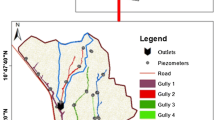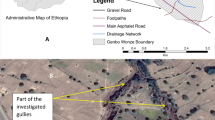Abstract
Well-established perennial vegetation in riparian areas of agricultural lands can stabilize the end points of gullies and reduce their overall erosion. The objective of this study was to investigate the impacts of riparian land management on gully erosion. A field survey documented the number of gullies and cattle access points in riparian forest buffers, grass filters, annual row-cropped fields, pastures in which the cattle were fenced out of the stream, and continuously, rotationally and intensive rotationally grazed pastures in three regions of Iowa. Gully lengths, depths and severely eroding bank areas were measured. Gullies exhibited few significant differences among riparian management practices. The most significant differences were exhibited between conservation and agricultural management practices, an indication that conservation practices could reduce gully erosion. Changes in pasture management from continuous to rotational or intensive rotational grazing showed no reductions in gully erosion. It is important to recognize that more significant differences among riparian management practices were not exhibited because the conservation and alternative grazing practices had recently been established. As gully formation is more impacted by upland than riparian management, gully stabilization might require additional upland conservation practices. The existence of numerous cattle access points in pastures where cattle have full access to the stream also indicates that these could be substantial sources of sediment for streams. Finally, the gully banks were less important sediment contributors to streams than the streambanks. The severely eroding bank areas in streams were six times greater than those in the gullies in the monitored reaches.



Similar content being viewed by others
References
Andersen KL (2000) Historical alterations of surface hydrology in Iowa’s small agricultural watersheds. Thesis (M.S.), Iowa State University, Ames, p 105
Beeson CE, Doyle PF (1995) Comparison of bank erosion at vegetated and non-vegetated channel bends. Water Resources Bulletin 31:983–990
Brooks KN, Ffolliott PF, Gregersen HM, DeBano LF (2003) Hydrology and the management of watersheds. Iowa State Press, Ames, p 574
Burkhart MR, Oberle SL, Hewitt MJ, Picklus J (1994) A framework for regional agroecosystems characterization using the national resources inventory. Journal of Environmental Quality 23:866–874
Chaplot V, Giboire G, Marchand P, Valentin C (2005) Dynamic modeling for linear erosion initiation and development under climate and land-use changes in northern Laos. Catena 63:318–328
Clary WP, Kinney JW (2002) Streambank and vegetation response to simulated cattle grazing. Wetlands 22:139–148
Diebel MW, Maxted JT, Robertson DM, Han S, Vander Zanden MJ (2009) Landscape planning for agricultural nonpoint source pollution reduction III: assessing phosphorus and sediment reduction potential. Environmental Management 43:69–83
Gomez B, Banbury K, Marden M, Trustrum NA, Peacock DH, Hoskin PJ (2003) Gully erosion and sediment production, Te Weraroa Stream, New Zealand. Water Resources Research 39(7):ESG 3-1-ESG 3-7
Iowa State University GIS (Geographic Information Systems) Support and Research Facility (2004) Digital Orthophoto Quads. http://ortho.gis.iastate.edu/index.html. Accessed online 9 June 2009
Knight KW, Schultz RC, Mabry CM, Isenhart TM (2010) Natural riparian forest buffers with and without planted grass filters as buffers of concentrated flow from row crop fields. Journal of the American Water Resources Association 46(2):311–322
Nearing MA, Priski FF, O’Neal MR (2004) Expected climate change impacts on soil erosion rates: a review. Journal of Soil and Water Conservation 59(1):43–50
Piest RF, Bowie AJ (1974) Gully and stream bank erosion. In: Land-use: persuasion of regulation. Proceedings of the 29th annual meeting of the soil conservation society of America. Soil Conservation Society of America, Ankeny, pp 188–196
Poesen J, Vandekerckhove L, Nachtergaele J, Oostwoud Wijdenes D, Verstraeten G, van Wesemael B (2002) Gully erosion in dryland environment. In: Bull LJ, Kirkby MJ (eds) Dryland rivers: hydrology and geomorphology of semi-arid channels. Wiley, Chichester, pp 229–262
Poesen J, Nachtergaele J, Verstraeten G, Valentin C (2003) Gully erosion and environmental change: Importance and research needs. Catena 50:91–133
Prior JC (1991) Landforms of Iowa. Iowa Department of Natural Resources. University of Iowa Press. Iowa, p 168
Rogovska NP, Cruse RM (2011) Climate Change Consequences for Agriculture in Iowa. In: Iowa Climate Change Impacts Committee (eds) climate change impacts on Iowa 2010. Report to the Governor and Iowa General Assembly. Des Moines, pp 14–18
SAS Institute (1999) SAS Release 8.1. SAS Institute, Cary
Schumm A (1999) Causes and control of channel incision. In: Darby SE, Simon A (eds) Incised rivers: processes, forms, engineering and management. Wiley, Chichester, pp 19–33
Simon A, Darby S (1999) The nature and significance of incised river channels. In: Darby SE, Simon A (eds) Incised rivers: processes, forms, engineering and management. Wiley, Chichester, pp 1–18
Simon A, Rinaldi M (2000) Channel instability in the Loess area of the Midwestern United States. Journal of the American Water Resources Association 36(1):133–150
Simon A, Rinaldi M, Hadish G (1996) Channel evolution in the loess area of the Midwestern United States. Proceedings of the sixth federal interagency sedimentation conference, Las Vegas. US Government Printing Office, Washington, DC, pp III86–III96
Soil Science Society of America (SSSA) (2001) Glossary of soil science terms. Available via soil science society of America. https://www.soils.org/publications/soils-glossary. Accessed online 5 Nov 2010
Soil Survey Geographic Database (SSURGO) (2004) Iowa cooperative survey. Available via Iowa State University geographic information systems support and research facility. http://icss.agron.iastate.edu/. Accessed online 30 Jan 2009
Stall JB (1985) Upland erosion and downstream sediment delivery. In: El-Swaify SA, Moldenhauer WC, Lo A (eds) Soil erosion and conservation. Soil Conservation Society of America, Ankeny, pp 200–205
Strahler AN (1957) Quantitative analysis of watershed geomorphology. Transactions of the American Geophysical Union 38:913–920
Thomas JT, Iverson NR, Burkart MR, Kramer LA (2004) Long-term growth of a valley-bottom gully, western Iowa. Earth Surface Process and Landforms 29:995–1009
Trimble SW (1999) Decreased rates of alluvial sediment storage in the Coon Creek Basin, Wisconsin, 1975–1993. Science 285:1244–1246
Trimble SW (2008) Man-induced soil erosion on the Southern Piedmont. Soil and Water Conservation Society, Ankeny, p 70
USDA-FSA (United States Department of Agriculture—Farm Service Agency) (2008) Conservation Programs. http://www.fsa.usda.gov/FSA/webapp?area=home&subject=copr&topic=crp. Accessed online 14 March 2011
USDA-NRCS (United States Department of Agriculture-Natural Resource Conservation Service) (1997a) Profitable Pastures. A guide to grass, grazing and good management. USDA-NRCS. Des Moines, p 20
USDA-NRCS (United States Department of Agriculture-Natural Resource Conservation Service) (1997b) Riparian forest buffer. Conservation practice standard, Code 392. USDA-NRCS, Des Moines, p 4
USDA-NRCS (United States Department of Agriculture-Natural Resource Conservation Service), (1997) Grass filters. Conservation practice standard, Code 393. USDA-NRCS, Des Moines, p 3
USDA-NRCS (United States Department of Agriculture-Natural Resource Conservation Service) (1998) Erosion and sediment delivery. Field office technical guide notice no. IA-198. USDA-NRCS, Des Moines, p 15
USDA-NRCS (United States Department of Agriculture-Natural Resource Conservation Service) (1999) Grassed waterway. Conservation practice standard, Code 412. USDA-NRCS, Des Moines, p 4
Valentin C, Poesen J, Li Y (2005) Gully erosion: impacts, factors and control. Catena 63:132–153
Webb RH, Hereford R (2001) Floods and geomorphic change in the southwestern United States: a historical perspective. Proceedings of the seventh federal interagency sedimentation conference, March 25–29, Reno, pp IV30–IV37
Whitney GG (1994) From coastal wilderness to fruited plains: a history of environmental change in temperate North America, 1500 to Present. Cambridge University Press, Cambridge, p 488
Zaimes GN, Schultz RC, Isenhart TM (2006) Riparian land-uses and precipitation influences on stream bank erosion in Central Iowa. Journal of the American Water Resources Association 42:83–97
Zaimes GN, Schultz RC, Isenhart TM (2008) Streambank soil and phosphorus losses under different riparian land-uses in Iowa. Journal of the American Water Resources Association 44:935–947
Acknowledgment
This research has been funded in its majority by the Iowa Department of Natural Resources under the Federal Nonpoint Source Management Program (Section 319 of the Clean Water Act) and in part by the University of Missouri Center for Agroforestry under cooperative agreements AG-02100251 with the USDA-ARS Dale Bumpers Small Farms Research Center, Booneville, AR and C R 826704-01-0 with the US EPA. The results presented are the sole responsibility of the authors and may not represent the policies or positions of the funding organizations. Firstly, we would like to thank Leigh Ann Long for her editing and revisions of the manuscript. Her input significantly improved the manuscript. We would also like to thank J. Herring, K. Kult, J. Love, M. Tufeckioglu and N. Zaimes for collecting data in the field. Finally, we would like to thank all the landowners that permitted us to use their farms as monitoring sites. This project would not have been possible without their cooperation.
Author information
Authors and Affiliations
Corresponding author
Rights and permissions
About this article
Cite this article
Zaimes, G.N., Schultz, R.C. Assessing Riparian Conservation Land Management Practice Impacts on Gully Erosion in Iowa. Environmental Management 49, 1009–1021 (2012). https://doi.org/10.1007/s00267-012-9830-9
Received:
Accepted:
Published:
Issue Date:
DOI: https://doi.org/10.1007/s00267-012-9830-9




